

Bhagavad-gita As It Is Chapter 2 Verse 59. Bhaktivedanta VedaBase: Bhagavad-gītā As It Is 2.59 viṣayā vinivartante nirāhārasya dehinaḥ rasa-varjaḿ raso 'py asya paraḿ dṛṣṭvā nivartate viṣayāḥ — objects for sense enjoyment; vinivartante — are practiced to be refrained from; nirāhārasya — by negative restrictions; dehinaḥ — for the embodied; rasa-varjam — giving up the taste; rasaḥ — sense of enjoyment; api — although there is; asya — his; param — far superior things; dṛṣṭvā — by experiencing; nivartate — he ceases from.

The embodied soul may be restricted from sense enjoyment, though the taste for sense objects remains. Unless one is transcendentally situated, it is not possible to cease from sense enjoyment. Copyright © The Bhaktivedanta Book Trust International, Inc.His Divine Grace A. Vasistha's Yoga (translated by swami Venkatesananda, read by Gurugillies) : Swami Venkatesananda (audio: Gurugillies)
The Concise Yoga Vasistha - Google Books. Sri Ramana Maharshi's Teaching. On scrutiny, supreme devotion and jnana are in nature one and the same.
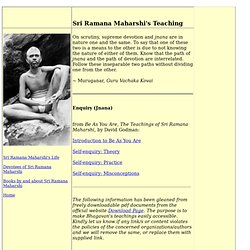
THE GOSPEL OF SRI RAMAKRISHNA : www.belurmath.org. Bhaktivedanta VedaBase Network. Its Mysteries and Control. By Twelfth Edition: 1994 World Wide Web (WWW) Edition : 1998 WWW site: This WWW reprint is for free distribution © The Divine Life Trust Society Published By THE DIVINE LIFE SOCIETY P.O. 1st July 1946.
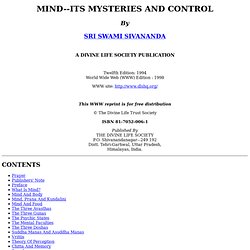
Verse 2.18-20 der Yoga Sutras: Gunas und das Selbst. Triguna Nachdem Patanjali in den ersten 17 Versen des Sadhana Pada im Yoga Sutra aus verschiedenen Perspektiven von der Befreiung aus dem Leiden gesprochen hat, beschreibt er nun weiter das Problem welches dahinter steckt.

Es ist Samyoga, die irrtümliche Verbindung des Wahrnehmenden “draṣṭa” mit dem Wahrgenommenen “dṛśyam”. Chapter 6: Chitradipa – Light on the Analogy of a Painted Picture, Verses 54-72 - Commentary on the Panchadasi. Upādāne vinaṣṭe’pi kṣaṇaṁ kāryaṁ pratīkṣate, ityāhus tārkikā stadvad asmākaṁ kim na saṁbhavet (54).
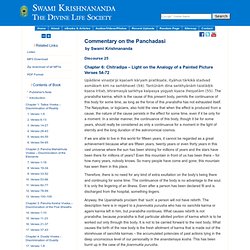
Tantūnāṁ dina saṅkhyānāṁ taistādṛk kṣaṇa īritaḥ, bhramasyā saṅkhya kalpasya yogyaḥ kṣaṇa iheṣyatām (55). The prarabdha karma, which is the cause of this present body, permits the continuance of this body for some time, as long as the force of this prarabdha has not exhausted itself. The Naiyayikas, or logicians, also hold the view that when the effect is produced from a cause, the nature of the cause persists in the effect for some time, even if it be only for a moment. In a similar manner, the continuance of this body, though it be for some years, should really be considered as only a continuance for a moment in the light of eternity and the long duration of the astronomical cosmos. Therefore, there is no need for any kind of extra exultation on the body’s being there and continuing for some time. Anyway, the Upanishads proclaim that ‘such’ a person will not have rebirth.
The Yoga Sutras of Patanjali. The Yoga Sutras of Patanjali The Threads of Union Translation by BonGiovanni 1. on Contemplations 2. on Spiritual Disciplines 3. on Divine Powers 4. on Realizations Before beginning any spiritual text it is customary to clear the mind of all distracting thoughts, to calm the breath and to purify the heart. 1.1 Now, instruction in Union. 1.2.

Yoga-Sutra 1 – Samadhi Pada: about enlightenment. The Aim of Yoga - The Study and Practice of Yoga - Chapter 1. The whole of our life is a successive series of efforts – whether it is the effort that I put forth, or that which someone else puts forth.

All these efforts have a common background, although the efforts of human beings are variegated and there is also an apparent diversity of the aims behind the efforts. The farmer's effort is towards producing harvest in the field; the industrialist's effort is towards production of goods and such other items in his field; the effort of the schoolmaster or the professor is in another direction; and so on and so forth. We have an apparent diversity of aims, motivated by a diversity of efforts. But this is a great illusion that is before us, and we live in a world of illusions which we mistake for realities. The Individual and the Absolute - Mandukya Upanishad. The first Mantra of the Mandukya Upanishad describes the nature of Omkara and its connotation in relation to the whole universe.
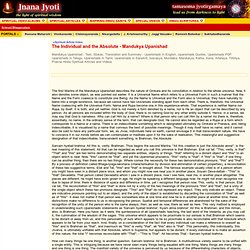
Now, it also denotes some object, as was pointed out earlier. It is a Universal Name which refers to a Universal Form in such a manner that the Name and the Form coalesce to constitute one Being. As the Name is Universal and the Form also is Universal, they have naturally to blend into a single existence, because we cannot have two Universals standing apart from each other. There is, therefore, the Universal Name coalescing with the Universal Form; Nama and Rupa become one in this experience-whole. That experience is neither Nama nor Rupa, by itself. Sarvam hyetad brahma: All this is, verily, Brahman.
How can many things be one thing, is another question. What are the essential characters of space and time? There are said to be five characters in all existence: Nama, Rupa, Asti, Bhati and Priya. We want perpetual existence. Chapter 1, Verse 1. Madhvacarya has no commentary so we present Baladeva Vidyabhusana's.
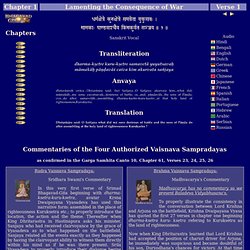
To properly illustrate the consistency in the conversation between Lord Krishna and Arjuna on the battlefield, Krishna Dvaipayana Vyasa has quoted the first 27 verses in chapter one beginning dharma-ksetra kuru-ksetra refering to Kuruksetra as the land of righteousness. Now when King Dhritarastra learned that Lord Krishna had accepted the position of chariot driver for Arjuna, he immediately was suspicious and became doubtful of his son, Duryodhana's chances for victory.
At that time he asked his minister Sanjaya a redundant question as what did his sons and the son of his brother do in the first verse of chapter one. Srimad Bhagavad-Gita begins with Dhritarastra asking Sanjaya: What did my sons and the sons of Pandu, assembled at the righteous land of Kuruksetra desirious of battle do? Ksetra also means field of cultivation.